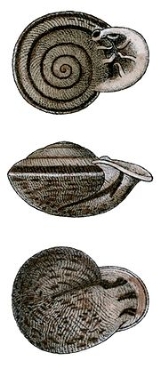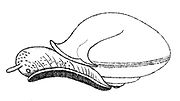
Ringicella ringens
Encyclopedia
Ringicella ringens is a species
of air-breathing land snail
, a terrestrial
pulmonate gastropod mollusk in the subfamily Bulimulinae, in the family Orthalicidae
.
It lives on the ground.

The shell
of this species is biconvex and solid. It is brownish-yellow in color, with a dark-brown band above the periphery, and another bordering the suture. The base of the shell is rather sparsely marked with irregular reddish-brown spots and usually has a dark stripe below the basal suture. The surface of the shell is only very slightly shiny. The last whorl
is densely corrugated in a zigzag pattern, but sometimes this sculpture is almost obsolete. The shell has 4 whorls
. The final whorl is carinated at the periphery, and has three deep, dark-colored grooves, as well as one small one behind the lip.
The aperture
of the shell is subhorizontal. It is elevated above the periphery of the shell and is obstructed by six white teeth. There are two strong lamellae on the parietal wall; these lamellae are compressed and curve upward within the aperture. The infraparietal lamella is stouter and straight. The outer lip of the peristome is broad, expanded and reflexed. It is white in color, its upper end perforated by an oval hole.
The outer margin of the peristome has four long folds within it, of which the columellar and the lower and upper palatal are subequal, the inner end of the latter being strongly bent upward. The suprapalatal fold is smaller and oblique, almost transverse. Above it is a small upper superpalatal fold, which has united with the angle-lamella to form the wall of the respiratory foramen, perforating the end of the lip.
The width of adult shells is 18–25 mm, the height is 10.5–13 mm.
Species
In biology, a species is one of the basic units of biological classification and a taxonomic rank. A species is often defined as a group of organisms capable of interbreeding and producing fertile offspring. While in many cases this definition is adequate, more precise or differing measures are...
of air-breathing land snail
Snail
Snail is a common name applied to most of the members of the molluscan class Gastropoda that have coiled shells in the adult stage. When the word is used in its most general sense, it includes sea snails, land snails and freshwater snails. The word snail without any qualifier is however more often...
, a terrestrial
Terrestrial animal
Terrestrial animals are animals that live predominantly or entirely on land , as compared with aquatic animals, which live predominantly or entirely in the water , or amphibians, which rely on a combination of aquatic and terrestrial habitats...
pulmonate gastropod mollusk in the subfamily Bulimulinae, in the family Orthalicidae
Orthalicidae
Orthalicidae are a family of tropical air-breathing land snails, terrestrial pulmonate gastropod mollusks are classified in the informal group Sigmurethra of the clade Stylommatophora...
.
Distribution
This species occurs in Brazil.It lives on the ground.

Shell description
Thomas Wyatt (1838) wrote about the shell of this species (as Anostoma globulosa): "Globose, with two small punctures, one on each side of the lip; slightly carinated, smooth, and white; margin reflected."The shell
Gastropod shell
The gastropod shell is a shell which is part of the body of a gastropod or snail, one kind of mollusc. The gastropod shell is an external skeleton or exoskeleton, which serves not only for muscle attachment, but also for protection from predators and from mechanical damage...
of this species is biconvex and solid. It is brownish-yellow in color, with a dark-brown band above the periphery, and another bordering the suture. The base of the shell is rather sparsely marked with irregular reddish-brown spots and usually has a dark stripe below the basal suture. The surface of the shell is only very slightly shiny. The last whorl
Body whorl
Body whorl is part of the morphology of a coiled gastropod mollusk.- In gastropods :In gastropods, the body whorl, or last whorl, is the most recently-formed and largest whorl of a spiral or helical shell, terminating in the aperture...
is densely corrugated in a zigzag pattern, but sometimes this sculpture is almost obsolete. The shell has 4 whorls
Whorl (mollusc)
A whorl is a single, complete 360° revolution or turn in the spiral growth of a mollusc shell. A spiral configuration of the shell is found in of numerous gastropods, but it is also found in shelled cephalopods including Nautilus, Spirula and the large extinct subclass of cephalopods known as the...
. The final whorl is carinated at the periphery, and has three deep, dark-colored grooves, as well as one small one behind the lip.
The aperture
Aperture (mollusc)
The aperture is an opening in certain kinds of mollusc shells: it is the main opening of the shell, where part of the body of the animal emerges for locomotion, feeding, etc....
of the shell is subhorizontal. It is elevated above the periphery of the shell and is obstructed by six white teeth. There are two strong lamellae on the parietal wall; these lamellae are compressed and curve upward within the aperture. The infraparietal lamella is stouter and straight. The outer lip of the peristome is broad, expanded and reflexed. It is white in color, its upper end perforated by an oval hole.
The outer margin of the peristome has four long folds within it, of which the columellar and the lower and upper palatal are subequal, the inner end of the latter being strongly bent upward. The suprapalatal fold is smaller and oblique, almost transverse. Above it is a small upper superpalatal fold, which has united with the angle-lamella to form the wall of the respiratory foramen, perforating the end of the lip.
The width of adult shells is 18–25 mm, the height is 10.5–13 mm.
Further reading
- J. L. de Barros Araujo 1963. SOBRE ANOSTOMA (RINGICELLA) RINGENS (L., 1758) (Gastropoda, Pulmonata, Odontostomidae). Mem. Inst. Oswaldo Cruz, 61(1): 149-152.
- Fischer P. 1869. Anatomie de l'Anostome. Jour. de Conchyl, 17: page 209-213, plate 11, figures 1-5.
- Fischer P. 1871. Note complementaire sur l'Anatomie de l'Anostome. Jour. de Conchyl, 19: page 261-263, plate 11, figures 4-8.

